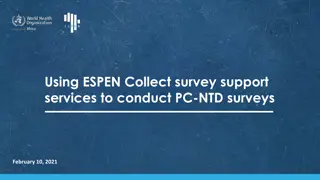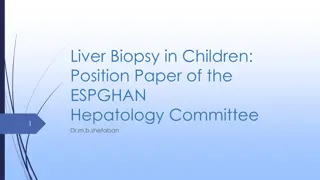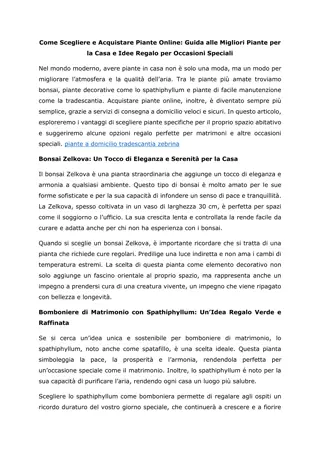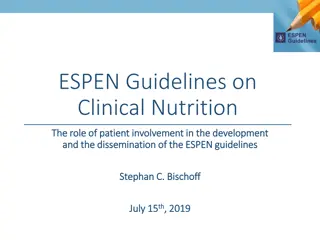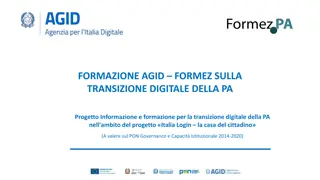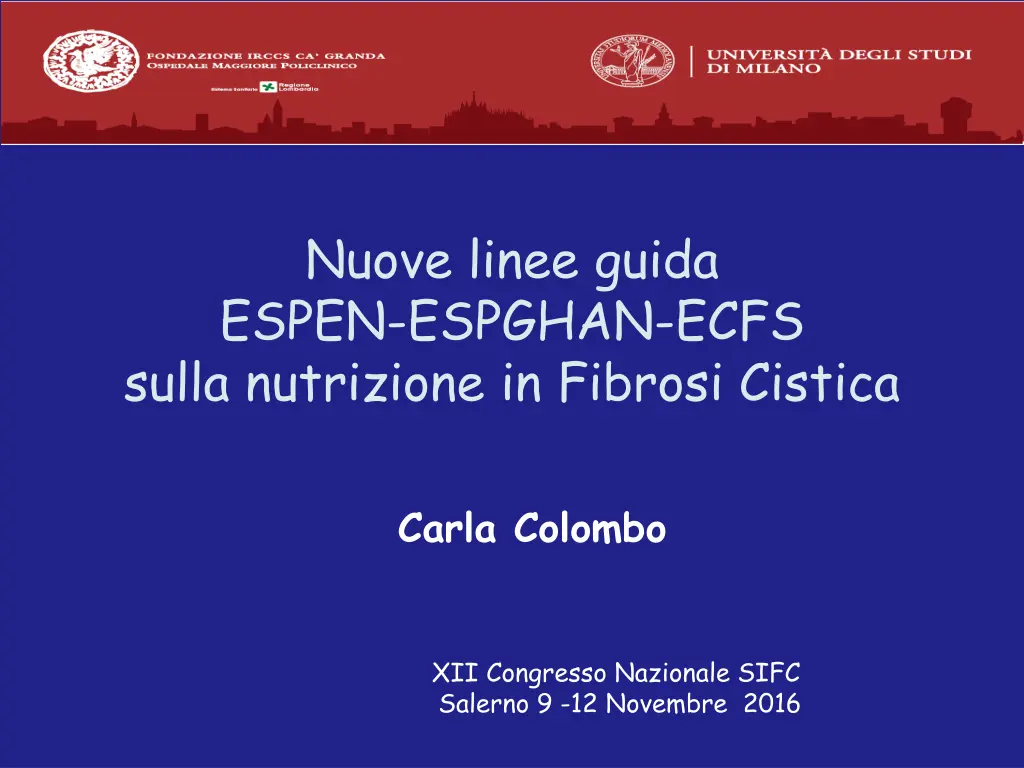
Nutritional Guidelines for Cystic Fibrosis Care
Learn about the latest nutritional guidelines for managing cystic fibrosis, including improving outcomes, multidisciplinary care, neonatal screening, and specialized nutrition interventions. Explore expert insights, Cochrane reviews, and guidelines for nutritional care topics. Stay informed on essential nutritional strategies for optimal CF care.
Download Presentation

Please find below an Image/Link to download the presentation.
The content on the website is provided AS IS for your information and personal use only. It may not be sold, licensed, or shared on other websites without obtaining consent from the author. If you encounter any issues during the download, it is possible that the publisher has removed the file from their server.
You are allowed to download the files provided on this website for personal or commercial use, subject to the condition that they are used lawfully. All files are the property of their respective owners.
The content on the website is provided AS IS for your information and personal use only. It may not be sold, licensed, or shared on other websites without obtaining consent from the author.
E N D
Presentation Transcript
Nuove linee guida ESPEN-ESPGHAN-ECFS sulla nutrizione in Fibrosi Cistica Carla Colombo XII Congresso Nazionale SIFC Salerno 9 -12 Novembre 2016
Improving outcomes for CF care Care delivered by multidisciplinary team in specialized Centers Neonatal screening best care for the screened infant Improvement in nutritional status Effective treatment of infection in the early years Transition to adult care optimal adult care New therapies ...the importance of clinical trial networks
ESPEN Cystic Fibrosis Guidelines Team Christian P Braegger, MD (Switzerland) Carla Colombo, MD (Italy) Dimitri Declercq, MSc (Belgium) Alison Morton, RD, BSc-Hons (UK) Ruzha Pancheva, MD, PhD (Bulgaria) Eddy Robberecht, MD, PhD (Belgium) Martin Stern, MD (Germany) Birgitta Strandvik, MD, PhD (Sweden) Sue Wolfe, RD, BSc-Hons (UK) Stephane M. Schneider, MD (France) Dominique Turck, MD (France) Michael Wilschanski, MBBS (Israel)
Cochrane Database of Systematic Reviews Francis DK, Smith J, Saljuqi T, Watling RM. Oral protein calorie supplementation for children with chronic disease. 2015, Issue 5. Morton A, Wolfe S. Enteral tube feeding for cystic fibrosis. 2015, Issue 4. Jagannath VA, Fedorowicz Z, Thaker V, Chang AB. Vitamin K supplementation for cystic fibrosis. 2015, Issue 1. Okebukola PO, Kansra S, Barrett J. Vitamin E supplementation in people with cystic fibrosis. 2014, Issue 12. Smyth RL, Rayner O. Oral calorie supplements for cystic fibrosis. 2014, Issue 11. Somaraju U, Solis-Moya A. Pancreatic enzyme replacement therapy for people with cystic fibrosis. 2014, Issue 10. Ciofu O, Lykkesfeldt J. Antioxidant supplementation for lung disease in cystic fibrosis. 2014, Issue 8. Bonifant CM, Shevill E, Chang AB. Vitamin A supplementation for cystic fibrosis. 2014, Issue 5. Ferguson JH, Chang AB. Vitamin D supplementation for cystic fibrosis. 2014, Issue 5 Oliver C, Watson H. Omega-3 fatty acids for cystic fibrosis. 2013, Issue 11
DEVELOPMENT OF GUIDELINES FOR CF NUTRITIONAL CARE TOPICS General guidelines statements Specific guidelines statements Assessment method and timing Feeding the newly diagnosed infant Feeding children and adults Balancing protein and fat intake Minerals, trace elements, vitamins Salt Treatment of pancreatic insufficiency Progression and intensified feeding Oral nutritional supplements Tube-fed enteral nutrition Parenteral nutrition CF-related disease with nutritional consequences Pregnancy Specialized nutrition-related treatments (essential fatty acids, growth hormone, appetite stimulants, probiotics, anti-osteoporotic agents
General recommendations for CF nutrition care Screen all newborns for CF, and initiate nutrition care early. Monitor nutritional status by routine assessment of relevant anthropometric parameters. Prevent or delay onset of nutrition deficits by nutrition counseling, high-energy intake, supplemental vitamins and minerals, and PERT. Advise parents/patients on balanced macronutrient intake, especially adequate protein and fat. Manage under-nutrition by diagnosing inadequacy, treating underlying causes, and compensating specific deficiencies.
Specific recommendations for CF nutrition care Assess bone health (dual-energy X-ray absorptiometry, DXA), including body composition , for all patients 8 years old. Assess calcium intake at least annually Screen all CF patients 10 years for glucose tolerance. For women with CF who are or plan to become pregnant, increase the frequency of monitoring and continuing after delivery. Assess pancreatic function yearly in pancreatic sufficient patients by fecal elastase-1, with the test repeated if growth is inadequate. GOE=Low
Pancreatic enzyme lipase replacement Age Suggested supplementation Infants (up to 12 months) breast milk intake and approximately 2000 U lipase/gram dietary fat in food Children 1 to 4 years 2000 to 4000 U lipase/gram dietary fat, increasing dose upward as needed Children > 4 years and adults titrating upward to a maximal dose of: 1000 to 2500 U lipase/kg BW per meal, or 10,000 U lipase/kg BW per day, or 2000 to 4000 U lipase/gram dietary fat taken with all fat-containing meals, snacks and drinks 2000-4000 U lipase/120 mL formula or estimated Consider starting at 500 U lipase/kg BW/meal,
Poster n 3 AIM of the Project The self-management of enzyme replacement in the European cystic fibrosis (CF) patients by means of a mobile application (APP) that allows for a personalised and accurate control and monitoring of insufficiency thanks to the interaction between health professionals and patients. pancreatic www.mycyfapp.eu
We recommend measuring weight and length or height at each clinic visit. GOE=Low We recommend using these levels to indicate adequate nutritional status: Infants and children 2 years: 50th percentile of weight and length for a healthy same-age population. Children 2 to 18 years: 50th percentile of the BMI for a healthy, same-age population Adults > 18 years BMI at or above 22 kg/m2 for females and 23 kg/m2 for males GOE=Low
Assessment of nutritional status Infants: weight and length/height at every visit; ideally monthly up to 1 year Children and adults: at least quarterly Plan more frequent monitoring in undernourished patients Growth/weight/bone measurement Annual review with blood tests Assessment of PERT need or adequacy of treatment by monitoring growth, nutritional status, and gastrointestinal symptoms Measure pulmonary function (FEV1) Nutrition monitoring Children: every 3 months Adults every 6 months Include questions about adherence to dietary advice Dietary review GOE=Low
WHAT S NEW? Energy recommendation on individual basis More attention to body composition and optimal protein needs Updates on sodium, vitamins, zinc Updated nutritional recommendations on bone disease, CF-related diabetes, liver disease, pregnancy Specialized nutrition-related treatments (EFA, anti-osteoporotic agents, GH, appetite stimulants, Probiotics)
Energy Targets Age Energy target 110% to 200% of energy requirements for same- age healthy infants and children 110% to 200% of energy requirements for same- age healthy children Detail Infants and children 2 years Energy intake should be adapted to achieve normal weight- and length- for-age percentiles Children 2 to 18 years Energy intake should be adapted to achieve target BMI percentile Adults > 18 years 110% to 200% of energy requirements for same- age healthy population Energy intake should be adapted to achieve BMI targets
Overweight and Obesity in CF 226 patients: 129 (57%) healthy weight 16 (7%) nutritional failure 28 (12%) at risk 35 (15%) overweight 18 (8%) obese we suggest adjusting energy intake to achieve normal growth and nutritional status while avoiding obesity . Hanna RM1, Weiner DJ. Overweight and obesity in patients with cystic fibrosis: a center-based analysis. Pediatr Pulmonol. 2015 Jan;50(1):35-41
The association between BMI categories and FEV1% predicted. Longitudinal trends in nutritional status and the relation between lung function and BMI in cystic fibrosis: a population-based cohort study. Stephenson AL1, Mannik LA, Walsh S, Brotherwood M, Robert R, Darling PB, Nisenbaum R, Moerman J, Stanojevic S. Am J Clin Nutr. 2013 Apr;97(4):872-7
PROTEIN NEEDS AND LEAN BODY MASS Newer studies suggest recommendations are also needed for increased intake of protein in order to maintain lean body mass and improve long term outcomes High fat mass but low lean body mass (reported in adolescents and adults with CF) does not necessarily correlate with better lung function, and in fact predicts poor CF disease prognosis. The long-term health effects of overweight and obesity suggest that balanced intake of protein and fat should be maintained when overall energy intake is increased. Further studies are needed to develop evidence-based recommendations for daily protein intake in children and adults with CF .
Sodium supplementation Europe vs US We recommend assessing infants needs for sodium supplementation on an individual basis, taking climate and sodium losses into consideration, by measuring fractional excretion of sodium (FENa) or urinary sodium: creatinine ratio Sodium supplement* 1 2 mmol per kg bw/day Age Detail Breastfed infants 0 to 6 months For infants at risk of sodium deficiency give salt in small portions throughout the day, diluted in water or fruit juice. Increase intake for infants living in hot ambient temperatures; or for those with increased fluid loss due to vomiting, fever, diarrhea, or tachypnea; or infants with ostomies. For infants with special considerations Up to 4 mmol per kg bw/day Older children through adults Supplement in stress situations when excessive sweating is expected (i.e., fever, exercise/sports, hot weather). Salty foods or sodium chloride capsules or vials
Daily zinc supplementation We suggest zinc supplementation for people with CF who are at risk of zinc insufficiency (e.g., growth retardation, increased susceptibility to infections, delayed sexual maturation, eye problems, and anorexia). GOE=Low Recommended supplementation Recommended dosing period Age Infants and children < 2 years and at risk of zinc insufficiency 1 mg/kg/day (max 15 mg/day) 6 months Children 2 to 18 years and at risk of zinc insufficiency 15 mg/day 6 months Adults > 18 years and at risk of zinc insufficiency 25 mg/day 6 months
Fat Soluble Vitamins Vitamin A bone Vitamin D vitamine Vitamin E Vitamin K bone
Vitamin A supplementation for pancreatic- insufficient patients Serum reference values and monitoring frequency Vitamin Supplementation Vitamin A Amounts dependent on serum values, and supplement form: Retinol (preformed): Start low Adapt rapidly to target normal serum reference range Beta carotene (provitamin A): Prescribe 1 mg/kg BW/day (maximum 50 mg/day) for 12 weeks Follow with maintenance dose (maximum 10 mg/day) Normal reference range provided by the laboratory processing the sample Monitor annually and 3 to 6 months after a dosage change. Also test when pregnancy is considered.
Vitamin D supplementation for pancreatic-insufficient patients Serum reference values and monitoring frequency Vitamin Supplementation Vitamin D Dependent on serum values, which vary with dietary intake and sun exposure: Starting dose of D3 (cholecalciferol) - Infants 400 IU/day (advance to upper limit of 1000 IU/day) - All others 800 IU/day (advance to upper limit of 2000 for children 1-10 years, and 4000 IU/day for older) Maintenance dose: adapt to annual serum values, preferably measured at the end of dark months Serum-25 (OH) D minimum 20 ng/mL (50nmol/L) Monitor annually, and check 3 to 6 months after a dosage change
Supplementation of vitamins E and K for pancreatic-insufficient patients Serum reference values and monitoring frequency Vitamin Supplementation Vitamin E (tocopherols) -tocopherol dosing: 100 to 400 IU/day 50 IU/day for infants < 12 mos (1mg = 1.49 IU) Plasma -tocopherol:cholesterol ratio > 5.4 mg/g Monitor annually, and check 3 to 6 months after a dosage change Vitamin K Vitamin K1 Infants: 0.3 to 1.0 mg/day Older children and adults: 1 to 10 mg/day Routine biochemical measurement not widely available
Nutritional recommendations for comorbidities
Guidelines: Nutrition intervention We recommend nutrition intervention based on a full review of nutrition status, including a detailed review of pancreatic enzyme replacement therapy (PERT), and correction of any underlying medical conditions. GOE=High We recommend using age-appropriate BMI-related thresholds for deciding when to advance nutrition intervention. GOE=High We recommend a progressive approach to intensification of nutrition interventions as needs increase: preventive nutritional counseling, dietary modification and/or oral nutrition supplements, and enteral tube feeding. GOE=Low
Feeding undernourished people with CF Decision point for intensified nutritional support Nutritional status and Intervention Children 2 to 18 years BMIp 50th percentile Adults > 18 years BMI: 18.5 to 22 (for females) 18.5 to 23 (for males), or No weight loss Infants 2 years Weight and length 50th percentile Normal nutritional status: Preventive nutritional counseling Special nutritional support: Diet modification and/or oral nutrition supplements Failure to thrive: weight and length 10th to 50th percentile BMIp 10th to 50th,or Weight loss in previous 2 to 4 months, or No weight gain in previous 2 months BMI < 18.5, or Weight loss of 5% in previous 2 months Persistent undernutrition: Enteral tube feeding Persistent failure to thrive weight and length < 10th percentile Persistently low BMIp (BMIp < 10th), or Weight loss of 2 percentile points since last visit Persistently low BMI (BMI < 18.5), or Continuing weight loss
On behalf of the ESPEN WG Thank you for your kind attention D Turck, C Braegger, C Colombo, A Morton, R Pancheva, E Robberecht, S Schneider, M Stern, B Strandvik, J Walkowiak, M Wilschanski, S Wolfe Clin Nutr. 2016 Jun;35(3):557-77.








